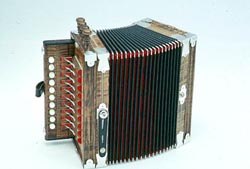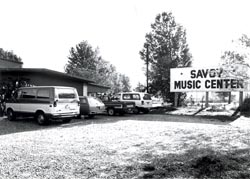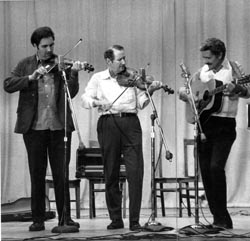Reminiscences of a Cajun Accordion Builder
By Marc Savoy
Editor's Note
Accordion builder and musician Marc Savoy of Eunice, Louisiana, helped to reignite Cajun culture. His Savoy Music Center and its Saturday morning jam sessions have attracted Cajun musicians for decades. He has played with many older musicians and has the Savoy Family Band with his wife Ann Savoy. The jam sessions at Savoy Music Center has been instrumental in getting younger musicians interested in their heritage. In 1992 he received the National Heritage Fellowship awarded by the National Endowment for the Arts. Here, he reminisces about his fascination about Cajun music, building accordions, and the music center.
Learning to Play Accordion at House Parties / bals de maison
In the mid-1940s, one of my grandfather's tenants lived in a catalpa grove across the fields from the farm where I grew up. Very often I would hear wonderful music coming from the direction of his home. I asked my dad what was making that music. He replied that it was a man by the name of Hiram Courville playing a squeezebox. "What is a squeezebox?" I asked. "An accordion" he replied. "What's an accordion?" I asked. Hiram Courville was a little skinny man with unusually large hands and long fingers. He would visit my father often to talk about the crops, but he never brought his accordion. So one day I asked him if he would please bring his accordion the next time he came for a visit. I had never seen an accordion before. I had heard the music from across the fields and was so interested to see what sort of contraption made those beautiful sounds. I had heard my grandfather play fiddle along with Dennis McGee, also a tenant farmer of my grandfather, but I was more attracted to the sounds that would drift from that catalpa grove to our house. Times were changing and tenant farmers were slowly being squeezed out of business by the larger farms that were developing. One day Hiram came over to tell my father that he was quitting farming and moving to Eunice to work as a carpenter's helper. The house that he lived in was pretty well run down and needed a lot of repair. Since it was built from cypress wood, it was still structurally sound. The following year my father decided to dismantle the house and reassemble it into a building behind our house. He wanted a place where he and his farmer neighbors could get together once in a while to cook supper, visit, and have a few beers.
Christmas time came along and my father decided to have a Christmas Eve party with music in the outdoor kitchen. He invited a bunch of friends, one of them being Hiram Courville, to play music for dancing. I was at last going to see Hiram play his accordion. That night was sheer heaven for me with Wade Frugé and Maxime Rozas on fiddles playing with Hiram. Wow! I sat next to them the entire night and didn't take my eyes off them. I was positive that that was as good as it gets. Life could be no better than that. All the other kids were outside shooting fireworks, but fireworks were going off in my heart and my head just being in the presence of those three simple, wonderful old guys. I was hooked for life, hooked to the point that I asked my father if he thought it would be possible to maybe have a New Year's Eve party also. I had to hear more. He said that would be too soon, but maybe in the spring for Mardi Gras.
I don't think I ever spent a longer period of time than I did waiting from Christmas to Mardi Gras. Finally the day arrived and we got ready for music party #2 in the outdoor kitchen. There was going to be the same trio providing the music, along with an uncle of Wade Frugé's by the name of Theoval Frugé. It seemed as though the party had just started when people began leaving. I asked my father why the party was breaking up. He replied that after 5 hours of music and dancing the people were getting tired and it was time to go home and go to bed. I couldn't imagine where the time had gone and I sure wasn't sleepy; however, I went to bed, even though it was impossible to sleep. I kept hearing those beautiful old tunes in my mind over and over again.
The next morning Hiram came over again for a visit to talk to my father. I found it strange that he would come over again the morning after the party and wondered what it was he wanted with my father. He said, "Joel, I've been noticing how your little boy seems to love accordion music. He watched us like a hawk all night long and never took his eyes off of our fingers while we were playing. I've never seen a kid so interested in music as your little boy. Maybe you should get him a fiddle or an accordion." I wasn't in the room, but I overheard the conversation. My father must have thought about that a lot, because it was several days later before he mentioned it.
My father had grown up surrounded by music, and if there ever was a music addict, he certainly was one. His father and brother were both fiddlers, but like myself, his love was accordion music. As a young man he tried to accumulate the $14 to buy a Monarch accordion, but with wages at 50 cents per day he never could get the extra money needed for the purchase. I guess he was also discouraged since both his father and brother disliked the accordion claiming that you couldn't play the "real" music on an accordion as you could on the fiddle. Nevertheless, one day my father asked me nonchalantly if I would have liked to have an accordion. My family wasn't poor, but neither did my folks have money to throw away on foolish things like accordions. When I was asked whether or not I would have liked an accordion for my Christmas present, I replied, "I guess so."
To me owning an accordion was about as far-fetched as owning the moon. At the time I didn't think that would have been possible. So my father ordered a Christmas present accordion from Sears Roebuck for $27.50. It came in a few days before Christmas, on the day the dove hunting season opened. The mailman delivered it to our house right at noontime, so I didn't unpack it yet. After lunch my father got his shotgun and asked if I wanted to go dove hunting with him. I told him no, that I wanted to stay and unpack my accordion. I wanted to be alone when I did this. I went to my bedroom and closed all the doors to have a look at my new Hohner. By this time, at age twelve (in 1952), I could whistle every one of Hiram's tunes by heart. I had watched him play so many times that I knew I could play that accordion. I opened up the bellows, listened to the sound of each button and played " J'ai Passe Devant Ta Porte." My mother came in the room and couldn't believe her eyes when she saw me playing. I had never touched an accordion before in my life, but I knew I could play it, and I did. Several hours later my father returned from his hunt and when he entered the house, he heard music coming from my bedroom. So, he jokingly asked my mom, "Why is Hiram here at our house playing music when he should be out dove hunting also?" My mom replied, "Hiram isn't here! Go see for yourself who is playing the accordion."
My father was one of those rare individuals who did everything very, very well. He had a fourth grade education, but was the neighborhood's best carpenter, best farmer, best gardener, best cook, best everything. Needless to say that at age twelve I wasn't the best at any of these things and was probably the worst at all of them. My father, being the perfectionist that he was, was very hard on me and I couldn't do anything to his satisfaction. My father came into my bedroom expecting to see Hiram playing my new accordion. When it dawned on him that Hiram wasn't there and that it was his son playing all that music, his eyes got as big as 50 cent pieces and his mouth moved but he couldn't say anything for several minutes. From that moment on and for the rest of his life it was no longer his "little boy who couldn't do anything right" but rather "Hey, everyone, come listen to my son Marc play the accordion!" From that point on I was lifted out of the mire and elevated to a throne.
The frequency of the music parties and bals de maison in the outdoor kitchen intensified to the point that maybe once a month we would have get-togethers, but it was rarely that I played. The social rule of those days was that children should be seen and not heard. I was allowed to be in the presence of the old timers provided that I keep quiet, which was alright with me. I was much more interested in listening to Hiram and Theoval to try to learn their style than I was interested in playing myself.
Hiram was considered by everyone to be the best accordion player anywhere. He had an ornate style that consisted of beautiful combinations of notes. His phrasings were intricate and his finger work was sheer art. He was a gentle and humble man who considered himself to be a mediocre player. His music was such a natural part of himself that he couldn't attach any more importance to it than to anything else that he did.
Theoval wasn't the artist that Hiram was, but he was wonderful in his own way. He didn't have Hiram's delicate touch or speed, but he had a rhythm and punctuation that was fantastic. Theoval Frugé, unlike Hiram, was a big stocky man with a ruddy completion and with fingers that resembled big pieces of sausage; but put an accordion in his hands and those big clumsy looking fingers could do some magic and make your feet dance. They were both my heroes, and I worshiped the ground they walked on. Both of my role models were such humble men, completely lacking any vanity whatsoever, to the point that they totally downplayed their talent. Since they felt that way about themselves, they also felt that way toward me. They never went "goo goo ga ga" over the fact that a twelve-year-old kid was a pretty darn good accordion player. It was this attitude of theirs that prevented me from being too eager to play, and therefore; caused me to sit down to watch, listen, and learn. Because of this situation I learned a lot of technique from these players.
There was a black man working on our farm who would talk to me about another black man by the name of Joyah Guidry who was a great accordion player. He would tell me that when Joyah was a bit younger he was considered to be a better player than the legendary Creole musician Amédé Ardoin and had taught Amédé how to play. When I found out that Joyah was still alive and lived in Ville Platte, I kept pestering the tenant until he finally consented to take me over to listen to him play. I was familiar with Amédé's music, because I would spend hours winding up the crank on my grandmother's Victrola playing her 78s of Amédé Ardoin. Also my father would tell me stories about how he had known Amédé very well and had once hired him to play for a house party in our kitchen before I was born. My friend took me to Ville Platte to listen to Joyah Guidry. I met a jolly old man who was very excited to have someone visiting him but was sort of puzzled about why a young white boy wanted to hear him play. He went into some back room and returned with an old Monarch accordion in excellent condition and started playing the " Eunice Two Step" exactly like Amédé's record. It was note for note the same as the old 78 I had heard so many times. It was so close to Amédé's playing that I told him he sounded just like Amédé Ardoin. He shook his head and said, "No, no, son, Amédé sounded like me. I taught that tune to Amédé."
Repairing Accordions
At this point I was familiar with the famed pre-World War II German-made Monarch and Sterling accordions. Joyah's Monarch had such a gutsy, rich tone compared to my little Hohner. He told me about another black man living in Cecelia who was doing some minor accordion repair including tuning the "musics" (Everyone in those days referred to the reeds as the "musics.") I wanted to know more about this "tuning" business, so I asked him to tell me about it. The information I received was pretty hazy, but it appeared as though the repairman would scratch—filing was what he meant—on the "musics," which were in the interior of the accordion. This action would change the sound of the "musics."
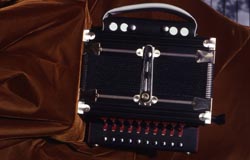
I returned home not just with a bunch of new tunes in my head, but with an idea that maybe something could be done to my little Hohner to make it sound more like Joyah's Monarch. I told my father about this, so he says, "Let's open up your Hohner to see what's inside." We detached the front of the accordion from the bellows and we saw all these little steel "things" inside. Some of these steel "things" (reeds) had scratch marks in different places and everything looked very complicated to a 15-year-old kid and his rice farming father. We quickly closed up the accordion and forgot about that for a while. Several months after that, a spring broke on the keyboard, so it's back inside the accordion again. I took the keyboard apart and removed the broken spring, but where to get another spring? My father told me that he had seen Amédé and others replace broken springs in their accordions with safety pins. I raided mom's pin cushion for something that looked like it might fit, reassembled the whole thing and it worked very well. Success! That wasn't so difficult after all.
This fact that Joel Savoy's kid had repaired his accordion spread through the neighborhood like wild fire. About two weeks later Hiram Courville came to our house, not just to visit Daddy, but to see if I could do the same spring repair on his accordion. With so many accordion players in the surrounding neighborhood, it wasn't long before I was doing some minor repairs for a lot of players. I bought a few old accordions just for spare parts and was also trying to figure out what effect that "scratching" had on the reeds. I realized that I was seriously handicapped if I couldn't learn to tune a reed.
I kept practicing and playing all the time and was slowly getting to be able to play like Hiram and Theoval. One day when I was about 17, some neighbors came to pick me up to go to a nearby campsite to entertain them while they had a cookout. It was in the late fall. During the evening a storm came up, the wind turned to the north, and the temperature dropped about 30 degrees. We were all huddled around the campfire when the proprietor of the campsite came over to invite us into his house to get out of the cold. I continued playing my accordion. Pretty soon the old man said to me:
Son, you're a good player for your age, but you need a better instrument. My son plays steel guitar with Sidney Brown of Lake Charles and Sidney just built himself a brand new accordion. You ought to buy yourself one of those Sidney Brown accordions. They sound a lot better than that thing you're playing. In fact, I just remembered that all the band's instruments are in the trunk of my son's car. Let me find the car key and I'll bring that accordion in.
Before I could question him about what he meant by "making an accordion," the old man went out to look for the accordion. I thought that surely I must have misunderstood him when he said "made an accordion." For a normal human being to build an accordion from scratch was totally impossible, or so I thought! The old man came back inside with a wooden case, opened it, took out a shiny black accordion with white trim, put it in my lap and said, "Here, play this!" First of all I looked it over very closely and saw that it was indeed brand new and looked identical to the famed pre-war Monarchs and Sterlings. I kept turning it over and over looking at everything while the old man was standing over me. Finally he said, "Play, play, play!" I ran my fingers over the keyboard a few times and then tried a tune.
I had played Monarchs and Sterlings many times before and I liked their tone. However, I was never impressed with the way they handled. I had always found them to require a lot of bellow action to keep the reeds speaking and also thought that the response was too slow. Hiram would always tell me that he didn't like the Monarchs and Sterlings because, when he tried to do a real fast, intricate riff, the little Hohner seemed to keep up with him better than the pre-wars. I, too, had begun to notice how sluggish those older accordions were, a fact that I attributed to their age. Even though most of the older players swore by the Monarchs and Sterlings, I just didn't feel like that was the ultimate accordion. After playing my first song on the Sidney Brown accordion, I was very impressed, not just with the fact that it was handmade, but also with the way it handled. It had the response of my Hohner, but with a much smoother keyboard action. The tone was also a major improvement. Unfortunately it did not quite have the bass response that the old pre-wars had. I don't remember sleeping at all that night, and it was during this long sleepless night (which was destined to be one of many) that I decided to build an accordion.
The next morning I told my father that I had seen and played a handmade accordion that looked identical to a Monarch. He said, "What? Say that again." He, too, couldn't believe that an accordion could be made locally by a Cajun. I'll never forget what my father said when I told him that I wanted to build an accordion also. He said, "We don't know anything about that." He used the word "we," which I knew meant that he was interested also. The idea remained dormant with me until 1960, when I was 20 years old. During that interval, I had figured out how to tune reeds and had also polished my accordion playing skills. Hiram and Theoval were getting old now and I found it rather sad that they were both losing that golden touch that had stolen my heart the first time I ever heard them. They both were very amused one day in 1960 when I announced to them that I had started building myself an accordion. By this time I had the opportunity to work on a few Sidney Brown accordions and had discovered that indeed the reeds, reed mounts, bellows, buttons, stops and straps all came from a Hohner accordion, so I decided to use the same.
So, using Hohner parts, I built something that looked like an accordion. At first I was so proud of my job. But the more I looked at it, the more I realized how bad it was. So one day not too long after I completed it, I lit a fire in the Bar-B-Que pit and burned it. I knew I could do a better job on the next one. So with a hand drill, an electric circular saw, and a lot of elbow grease and patience I built #2, which actually I was pretty satisfied with. I was playing house dances around the area using my #2 accordion, and the word began to get around that I was playing an accordion that I had built myself. It was at one of these house dances that a man came up to see my accordion, and after looking it over for some time, asked me how much I would charge to build one for him. My first customer! Number three led to number four and so on. I named by brand "Acadian."
Building Accordions
We had very few electric hand tools on our farm. My father had a nice selection of very fine hand tools, but I soon realized that the one thing that I had to have access to was a table saw. My father had a cousin that worked in a cabinet shop in Eunice and maybe the cousin could speak to the owner, a Mr. E. B. Feucht, and get permission for me to use their table saw. A few days later Mr. Feucht sent word to Dad and me that he would grant permission for me to use his saw but would need to talk to both of us first. We went over to the shop one morning when they were busy making cabinets and we met a very amiable Mr. Feucht. He wanted to know what I was working on that required the use of a table saw. When I explained that it was an accordion that I was building, I could tell that he found that very amusing. After giving me a crash course on how the table saw functioned and stressing how dangerous it was, he granted me access to his shop on Saturday mornings. He made it clear to my dad and me that he wasn't going to be responsible in the event of any accidents. We shook hands together to confirm the agreement. From that point on, for several weeks, my Saturday mornings would find me at Mr. Feucht's cabinet shop. I still remember, to this day, Mr. Feucht's crash course on the table saw safety and it's probably due to his teachings that years later, in 2018, I am fortunate never to have had an accident in all of the thousands of hours spent at a table saw. I also remember with fondness the kindness and encouragement he extended to me as he saw my project beginning to take form.
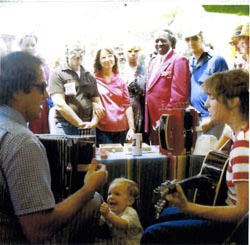
Time marches on. I purchased a small table saw and drill press, and I began making exact copies of the 'Tit Noir keyboard, "little black," which is what the Cajun accordion was called. Because I had been playing accordion since 1952 and had become a player of some renown, I began to be more demanding and critical of the instruments I was making, especially the action of the keyboard. Up to this point my work consisted mostly of duplicating the measurements of the 'Tit Noir. Slowly I began to question these measurements and slowly began to experiment with a different set of measurements. These improvements would eventually make me brave enough to question other features that would eventually lead to improvements in response, construction techniques, comfort, and overall appearance.
One day a man from Oberlin—my reputation had spread 30 miles!—came over with a piano key accordion that had a sour reed. It was a German-made instrument but not a Hohner and contained reeds that were also not Hohner. What a surprise! It was a fairly new accordion and very fine quality. Could it be possible that both Hiram and Wade (and many others) were wrong in believing that all accordion factories other than Hohner were bombed off the face of the earth? I had pretty well fine-tuned my woodworking by this time but realized that unless I could get better reeds than those contained in my little Hohner, I wasn't going to succeed in building the accordion of my dreams. When I saw the reeds in this piano key accordion, it dawned on me that there was surely someone else in Germany besides Hohner building reeds, and if there was one other, there might also be two, three, or four others.
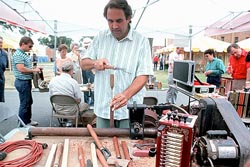
My father had leased some of his farm property to an oil company from Houston, Texas. Our family got to be good friends with the agent representing this Texas company. He was very interested in my accordion "hobby" and would always ask a lot of questions. I explained my dilemma to him about how I wished I could go to Germany to find some accordion reed factories. He told me that it wasn't necessary for me to go any further than a place in Houston called the International Trade Mart. "What is that?" I asked. He described it as a place that listed the names and addresses of everyone manufacturing anything in the entire world! So the next morning I boarded the passenger train, which in those days ran west through Eunice. I arrived at the International Trade Mart in Houston, went inside to the information desk, and was confronted with an elderly lady with a gruff and abrasive personality. However, I was not to be deterred by this obstacle. I had come too far to turn back now. I told her that I was searching for the names of German factories that could supply musical instrument parts. "What kind of musical instruments?" she asked. "Accordions," I answered. She replied, "Be more specific. What kind of parts?" "Reeds," I told her. She looked at me for what seemed an eternity without saying a word. She was thinking. Suddenly she blurted out, "I think you're looking in the wrong haystack. You should be looking in Italy."
How did she know that obscure fact and why was she working at the information desk that morning? Fate! I dared not argue with her, but I thought to myself that she was dead wrong; reeds come from Germany. I meekly followed her as she led me up many floors, entered a room and went right up to an enormous book, flipped through many pages and exclaimed, "Ah ha, I knew it. Here is what you are looking for." And there they were: names and addresses of factories in Italy that manufactured accordion reeds, bellows, etc. Many weeks later while eating lunch, we heard the mailman tooting his horn at the mailbox. I ran out to the road thinking we had a package. The postman was all excited because he had an air mail letter addressed to me from ITALY. It read, "Dear Sir, We can supply you with reeds of the finest quality." Now! Now I believed that I would be able to make the Cajuns forget about their Sterlings and Monarchs.
The fame of the shiny black pre-war Monarchs and Sterlings had probably developed from the fact that the earlier German-made instruments were not very good quality. The "reeds on individual plates" concept had not developed yet and the accordions that preceded the Monarch/Sterling had 20 reeds mounted on one single brass plate, which meant that if one reed broke, the entire plate would have to be replaced. The reed plates resembled that of a harmonica. These earlier instruments also had reed tongues of bell metal, a brass alloy, which produced a very weak sort of tone. By the time the Monarch arrived, separate reeds on individual plates were their big selling point. The reed tongues were really broad steel which produced a tremendous volume as compared to those of bell metal. So with such major improvements, of course, the Monarch/ Sterling was considered king.
The Cajuns' love affair with the 'Tit Noir was such that the rule of thumb in those days, was "if it wasn't black, it wasn't good." Undoubtedly that originated from the fact that the earlier instruments, which were of very poor quality, were either red, yellow, or green. Many of the new multi-colored Hohner HA114s were taken out of the box and completely covered with black spray paint. Convincing the Cajuns that Italian reeds were much superior to anything else was an uphill battle in itself, much less offering accordions built from beautiful figured woods with a clear finish instead of black paint. By contradicting the status quo, I was putting myself in a tough situation, but that was ok. I thought that was a small price to pay if I could change some attitudes. Nevertheless, I eventually did find a source of wood other than pine 2x4s, and I began experimenting with many different colors, types, and weights.
One day a local cabinet maker—and also a fine accordion player—brought over a board of reddish brown wood with a beautiful grain, wavy and sort of marbleized, and asked if I would make an accordion for him using that wood. He wanted that wood because it was somewhat heavier than the lumberyard pine I had been using, and he thought that my pine "Acadians" were a little too light. He wasn't interested in the wood because of its color and beauty and, of course, wanted it black. I had never seen wood like this before (later I found out that it was cherry). I got the idea of putting a clear finish instead of black paint so the beauty of the wood could be seen. At first it was, "No! No!" but I kept working on him—Give them what they want? Never!—until I got him to agree to a natural finish. I delivered the instrument, and the customer was very satisfied. I decided to try that again if I could find a source of woods other than pine 2x4s. Several weeks later, the cabinet maker returned with his "Acadian" and told me that he loved the accordion but asked me if I would please paint it black. I read a quotation once which said, "No one ever went broke underestimating the taste of the American public."
Savoy Music Center
By the fall of 1965, I had pretty much taken up my father's outdoor kitchen with my accordion building hobby. Accordion parts were scattered all over the place. Sawdust from woodworking covered all the surfaces, so my father, who realized that I had developed a pretty good little business with accordions, told me one day, "Well, it looks like you want to be a musician and instrument maker. Since I would like to have my outdoor kitchen back, would you please re-establish yourself somewhere else?" He owned some commercial property on a major highway and suggested that would be a good place to put up a little building to pursue my endeavor. He also suggested that I might carry a few supplies that were needed by the local Cajun musicians. This led me to start thinking about maybe building a full scale music store that would cater to the needs of local musicians. There had been attempts at music stores in Eunice before 1965, but they had always failed. I remembered that in 1952, when my father wanted to buy my Christmas-present accordion, he had to order it from Sears Roebuck because the local music store didn't carry accordions. Because of my close involvement with the Cajun people, I quickly recognized the potential for a music business in my area, provided of course that the store would specialize in music that was indigenous to our area. I figured that if you lived in the middle of the Sahara Desert, it wasn't much use to manufacture sailboats, and therefore I reasoned that all previous music stores in my area had failed because they underestimated the power of Cajun music.
On November 19, 1966, I opened the doors to Savoy Music Center. I remember three people telling me that day that I wouldn't stay open more than 90 days. They said it was unheard of for someone to open up a music store in the middle of a cotton field so far away from the city. What they really meant was that it was unheard of for someone to open up a business that specialized in Cajun music. In those days, Cajun was still a dirty word to many people. Being Cajun usually meant that you were not too bright, poor, and socially from the wrong side of the tracks. I didn't agree with any of this. On the contrary, I thought that they were extremely perceptive, innovative, industrious, and very talented—earthy, yes; but never socially improper. One thing that I found interesting about the older Cajun people was their unique manner of doing things, the special way they looked at life, their special style of playing a tune, the special way they phrased their language, their connection with nature and their love and respect for all of creation. These were qualities that were the common denominator for older generation Cajuns regardless of which parish they resided in. It was true that many had never had the opportunity to go to school and had to work in the fields instead for their survival. They were, therefore, not educated far beyond their intelligence as were many of the Anglos that were making derogatory jokes against the Cajuns. Looking back to my early years, I think that my ulterior motive in opening up such a business was to prove to the Cajuns and non-Cajuns alike that heritage and success could coexist. You could conduct business in the French language just as well as in English. You don't have to give up the things that make you who and what you are to be successful in this world. It was ok to be different from the mainstream.
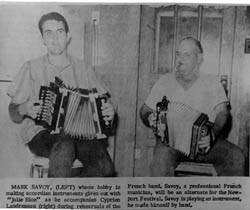
The demand for Cajun accordions was localized to Acadiana in 1966, and tourism hadn't begun yet. I knew deep down in my soul that one day this music of ours, the food, these wonderful, simple, friendly, charismatic Cajun people would be discovered by the rest of the world and the interest in the area would explode. Until that happened, though, how did I survive and make a go of my investment? It was going to be sink or swim for the next 10 long years. I can best describe those days as a financial nightmare. I had a very small inventory, lots of bills to pay, many problems to overcome, but equal, if not larger, amounts of drive and energy. I was playing dances three nights a week so I could support my personal needs from that. As far as the business was concerned, my only consistent income was from accordion building. The problem, however, was how to manufacture these instruments, without any specialized equipment, on a scale large enough to make it economically feasible.
One day while I was pouring the cement slab for the building's foundation, a friend dropped by to talk awhile. He was with a middle-aged man who quickly asked me what I was building. "A music store," I replied. "Could I get a job here?" he asked. When I inquired what it was that he could do, he replied, "Anything!" So I asked him "if you are so talented, why aren't you working?" "I just got out of jail." he answered. I immediately said, "You're hired." I figured anyone that blunt about such a matter had to be pretty special. I told him that I couldn't pay him much and he said he didn't care. I shook hands with Benton Daigle, and it was the beginning of a most fascinating friendship. He was by far the most amazing character I ever met. We poured the cement slab and Benton was a very good cement finisher. We started the plumbing and electrical, and Benton was an expert in both. We began the interior carpentry, and Benton was a master. My Volkswagen bug would break down, and Benton was the best mechanic around. The day after my grand opening, Benton entered the room that was designed to be the accordion shop and said to me, "Let's get to work! Show me how you make an accordion." I began making my "Acadian" brand accordion in 1960, so I had six years' experience over Benton Daigle. During this time I had acquired a certain amount of knowledge about the craft, but everything had evolved slowly, since I didn't have anyone to show me anything. In those days the basic information and raw materials were not available in the small towns on the farming prairie. I could go to the lumber store and buy a pine board, but where do you find something like maple or rosewood? I could go to the hardware store and buy paint, but where do you go for lacquer? Where could you find the countless specialty items needed for building an accordion? Needless to say, those items were not to be found in Eunice, so my evolution proceeded quite slowly. I showed Benton the process by which the components were built. He would think about that for a while, study the parts carefully and say, "Why don't you do it this way? If we make an assembly section of the parts instead, then that will allow us to produce many parts from one section, rather than one single piece." I learned more from Benton Daigle in one year than I had learned the previous six.
Saturday Morning Jam Sessions
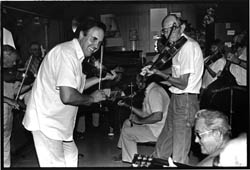
Before the days of online payments, it was a Cajun tradition among the farming people to get all gussied up on Saturday to go to town to shop and/or pay their accounts at places like the feed store, hardware store, and tractor supply. The owners of these establishments, as a show of appreciation for the farmers' business, would always have a hot pot of coffee on the counter, along with either doughnuts, boudin, or cracklins. The farmer would meet his neighbors in these establishments and would discuss farming practices, crop prices and yields, and weather conditions. Although my father came from a long line of farmers, I myself never developed an interest in any aspect of farming. However, I always accompanied him because I liked the doughnuts and boudin. I also enjoyed the sense of community that was strongly present in these establishments.
When I opened the doors to this business, I set out to try to re-create the same spirit I had so much enjoyed as a child. Since I didn't sell tractor fuel or chicken feed, the only other thing I had to offer was music. Saturdays were always considered non-work days for the Cajuns, so a few customers would drop by to drink a cup of coffee, take an instrument off the counter, and play a few tunes.
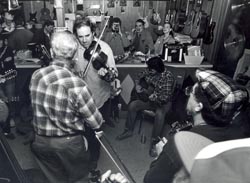
Very slowly the word got out that a few guys were playing music at Savoy Music Center every Saturday morning. Very slowly I began seeing a few other local faces that I knew were not musicians, but rather, people who just enjoyed listening to the music. It was especially appealing to the older generation of musicians who didn't play the style of music that was currently popular in the dancehalls. This older generation included my old friends and mentors whom I had grown up with, having first heard their music in the bals de maison at my father's home in the 1950s. Perhaps they were no longer popular and in demand in the current scene, but to me they were my heroes. I made certain that they knew that here at Savoy Music Center they were important, and that they were considered valuable assets to the Cajun music scene. To list all the names of the early jammers at Savoy Music Center would read like a Who's Who of Cajun Music in Louisiana.
Attracting Younger Musicians
However, there was one important element missing in this scene that would ensure its sustainability—the younger generation! If this culture would be propelled into the next time period, that feat would have to be accomplished by the younger generation. In the late 1950s and early 1960s an interest in Cajun music from the younger generation was virtually non-existent.
Because of their age and valuable knowledge of this culture, it has always been my attitude that the older musicians lead this jam session. Children are most welcome, but are encouraged to remain and play in the background to listen to and learn not just the tunes, but also the stories exchanged between the older musicians about the music and how it fits into their lives. It's a learning situation in which the younger generation can acquire a sensibility about the music and culture.
The jam session today in 2018 seems to function quite naturally. Structured scheduling concerning repertoire or who-plays-what does not exist. The musicians themselves are all old friends and seem to have an innate sense of "jam session etiquette". During the three hour session the line-up of musicians seems to be constantly changing; one wave comes in, plays a few tunes, and socializes a while with friends, then leaves while another wave is coming in to take their places. The feeling of the jam session is that of an old-time house dance. It isn't a performance because no one is "performing;" rather it's a get-together of friends to play the music of their heritage.
The Impact of the 1964 Newport Folk Festival
There was a change looming on the horizon that was destined to change all this, and that change was to be brought about by the Newport Folk Festival of Newport, Rhode Island. If any one thing can account for the renaissance of Cajun culture, it definitely was the Newport Folk Festival of 1964. Cajun culture would never be the same. Louisiana was in for a big awakening, but that wouldn't happen before another two decades had passed. Cajun culture would eventually be listed as one of Louisiana's greatest natural resources, but at that time very few state officials, if any, were aware of the value and potential of any culture to be attractive for tourism.
The musicians returned from Newport with stories about how the audience responded more favorably to Cajun music than they had to the headliners such as Bob Dylan or Peter, Paul, and Mary. They would tell stories about how the media—CBS, NBC, BBC, ABC—would follow them around every day for interviews to find out more about this mystical place called Louisiana, where the people speak French instead of English, play this wonderful dance music instead of rock'n'roll, and cook this wonderful food instead of American hot dogs.
The filmmakers and media flooded into Louisiana. Wow! Some brand-new news for the media to present to the world! Imagine the pride in the Cajuns of Louisiana when the media began coming into Louisiana to film all things Cajun. The media and filmmakers were here, not to film and document things "all American," but rather, to film and document everything that wasn't "all American." If any one thing can be credited with Cajuns seeing their heritage as an asset instead of the stigma it had become, it was definitely the media and filmmakers of those days.
These stories that the musicians told when they returned from Newport in 1964 were instrumental in my concept of building Savoy Music Center, a music store that would specialize in all things Cajun. I had always felt that it was only a matter of time before the world would discover that the culture we had here in Louisiana behind this cultural "Iron Curtain" was a treasure.
I felt positive that if the world could somehow find out about this amazing culture of ours, people from all over the world would want to come to Louisiana and experience it. The early media and filmmakers most certainly accomplished this. The Savoy Music Center jam session has been filmed by Good Morning America of New York and featured in both the National Geographic and Smithsonian magazines, to name just a few.
Besides attracting visitors from all over the world, this publicity by the media of the jam sessions also created a cultural awareness among the younger generation of Cajuns in their desire to learn the language, music, stories and all other facets of their heritage. Some of the most popular young Cajun musicians playing Cajun music today learned their music from sitting quietly in the corner of the room playing behind masters such as Dennis McGee, Dewey Balfa, Aldus Roger, Octa Clark, Milton Adams, and Jack Leger.
The Documentary Film Spend It All
One afternoon in 1967, into the store walks several long-haired hippy-looking strangers, who announced that they were here to make a documentary film on Cajun Louisiana. I told the film group leader—a Mr. Les Blank—that I was very sorry but he caught both Benton and I at a bad time. Several weeks earlier we had bottled a batch of home brew beer, and we had plans that evening to go out in the woods to cook a little supper and drink our prematurely capped beer. He asked if they could come along, and since we had both enough food and home brew for everyone, we invited them to join us. The next day we unanimously agreed that it was the unusual potency of the home brew that caused the film crew to have to spend the entire night sleeping on the ground in the woods. Early the next morning Benton and I, with a lot of black coffee returned to the campsite to revive our California guests.
Les' film on the Cajuns, Spend it All, was destined to become the classic of all Cajun documentaries. Released in 1971, it was very well received at film festivals both nationally and internationally. The success of this film, along with the response of the prestigious Newport Folk Festival toward Cajun music in 1964, slowly began a snowball effect. Cajun culture was finally discovered by the rest of the world and Louisiana would never be the same.
Ponderings of a Reincarnated Neanderthal
Sixty-one years have passed since I encountered my first Sydney Brown accordion in 1957. Fifty-eight years have passed now since I built my first acadian accordion in 1960 in my father's outdoor kitchen, which is now my son's music recording studio. Fifty-two years have passed since I decided to open a music center devoted Cajun music in 1966. The old outdoor kitchen probably couldn't hold all the accordions I've built since then. My old mentors, Hiram and Theoval, have passed on, as well as my brilliant friend Benton. I miss them and still mourn their passing. I don't think the world will ever see these kinds of characters ever again.
Now in 2018, there are about 25 people building Cajun style accordions, a far cry from only Sidney Brown in the 1950s and myself in the 1960s. Accordion makers are not just in Louisiana, but in other states as well as in Canada, France, England, and Finland. Louisiana-made instruments are being shipped around the globe to Sydney, Australia; Galway, Ireland; Edinburgh, Scotland; Paris, France; and others.
Fifty-two years after my grand opening, when my friends made their dire predictions that I would not stay open for more than 90 days because they thought I was too far out-of-town, I ask myself the question; "Which town was I too far from?" The single row diatonic accordion, initially known as the German-style accordion, is no longer manufactured in Germany. Instead they are now manufactured in Louisiana, have become internationally known as Cajun style, and are being exported to Germany not for the purpose of playing German folk music but rather to play Cajun music. Louisiana artisans producing these instruments have raised the bar of excellence to such a degree that these instruments are no longer considered only as utilitarian objects. They have finally taken their rightful place as an "objet d'art" and are also quickly becoming the iconic image of Louisiana's Cajun culture.
What if Sidney Brown would not have possessed the idea that a Cajun accordion could be handmade? What if that very knowledgeable elderly lady had not been working at the International Trade Mart on the day that I went there looking for supplies of reeds and bellows? Without better accordions, Cajun music would probably have slowly faded into obscurity and following in its footsteps would have been all the other aspects of the culture since the music always was and still is the glue that holds the culture together.


